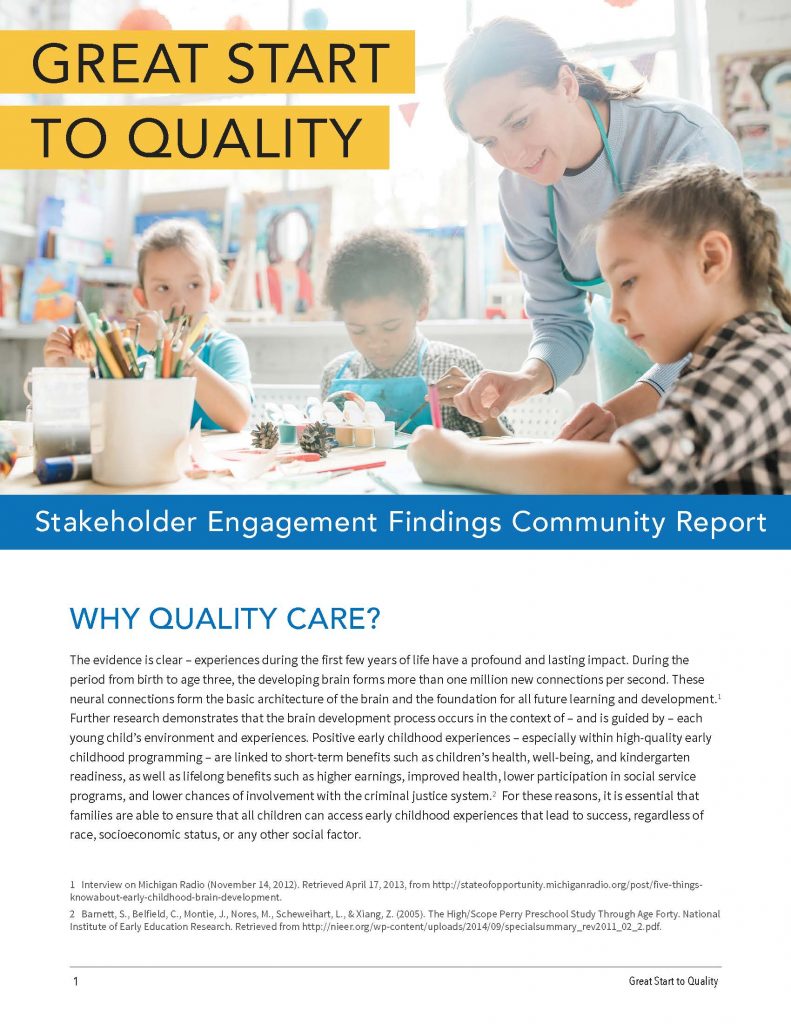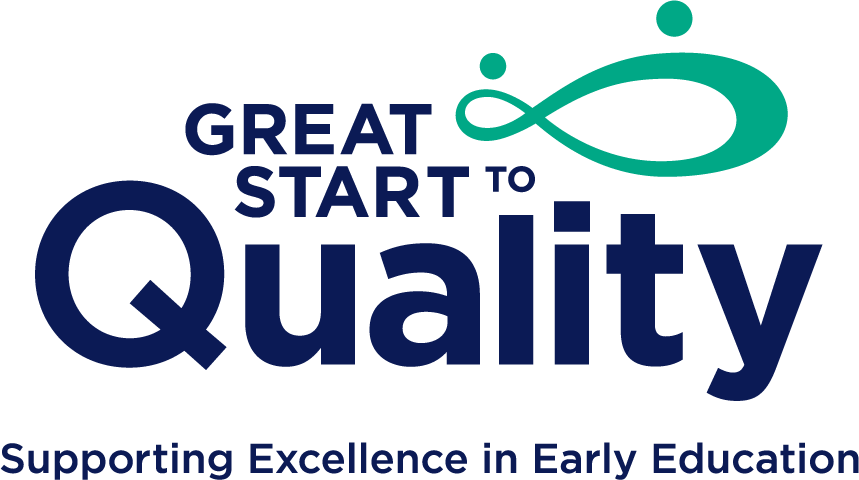
The Revision Process
Focused Quality Improvement Process Launched February 2023
Great Start to Quality (GSQ) strives to help families make informed decisions about child care and support child care programs as they improve their quality and provide the best care possible for children. Since launching GSQ in 2011, we’ve learned a lot about how to define and assess quality and how to help child care professionals improve services for children. Based on your feedback and guidance from content experts, we are in the process of improving the Great Start to Quality system.
Bookmark this page to track progress, offer your feedback, and get a preview of the changes. We also have a monthly newsletter! Sign up today.
Validation Study
In 2018, the Michigan Department of Education-Office of Great Start funded an independent study of Great Start to Quality to determine:
- if and how GSQ measures “quality” for licensed centers and home-based providers; and
- the difference between ratings in terms of quality.
The report published in 2019, which included 182 programs, provided recommendations for improving the rating process based on the study results.
Stakeholder Feedback

In 2020, feedback from providers, families, child care licensing, community partners, and others was gathered through surveys, interviews and focus groups.
The Latest News
Stay informed about the improvements to the Great Start to Quality and what you can do to be ready for the changes. Communications will be linked here once they are published.
- First Edition – February 2021
- Pilot Opportunity – March 2021
- Pilot Update – April 2021
- Using CLASS – May 2021
- GSQ/CLASS Overview – June 2021
- Second Pilot-June 2021
- Pilot Complete, CLASS Training-July 2021
- Curriculum Approval Process – August 2021
- Model, Indicators, and CLASS-October 2021
- A New Model – December 2021
- Great Start to Quality Revisions – January 2022
Step 1: Convene an Advisory Committee
This work began in the fall of 2019 when a group of 24 providers, partners, and stakeholders came together to make recommendations to improve Great Start to Quality. They represent diverse perspectives and all regions of the state.
Step 2: Listen to Families and Child Care Professionals
The Advisory Committee started its work by listening to feedback from child care professionals and parents across Michigan. They also engaged national experts and learned about how other states are focusing on quality.
Your voice matters. So far, over 3,600 child care professionals and parents have participated in this process—primarily by completing a survey about GSQ. (See a full report of their perspectives in the Next Steps for Michigan’s Great Start to Quality report.) If you want to share feedback with the Great Start to Quality Advisory Committee, you can send an email to greatstarttoquality@ecic4kids.org. Families and child care professionals provide important insights, and we’re grateful for your input!
Step 3: Develop Recommendations
Based on this feedback, the Advisory Committee developed recommendations about:
- The 5 Categories of Quality
- The indicators used to measure quality
- How to focus more on improvement, rather than rating
- How to talk clearly about ratings
- And more
Step 4: Adopt Recommendations and Plan for Implementation
The Advisory Committee developed recommendations that were shared with the Michigan Department of Education-Office of Great Start. These recommendations were reviewed and approved by the Michigan Department of Education-Office of Great Start. Plans for implementing improvements are in place and include communication, training, and system changes.
Providers Giving Input
One of the first goals for improvement is to simplify the Quality Indicators, making them easier for child care providers to understand and more relevant to home-based providers. To make sure the changes meet this goal, while continuing to measure different quality levels, child care providers from across Michigan were invited to review the revised Quality Indicators. Providers helped to see if the language is clearer and to: Compare program scores between the current GSQ Quality Indicators and proposed indicators
- Develop the points structure for the revised indicators
- Determine the right number of levels
- Ensure language was clear and supportive
A small $200 stipend was given to providers who completed the pilot process as a thank you.
Pilot 1
The first pilot took place through April 2021. Over 400 providers expressed interest and 206 were chosen to represent diverse program types, ages served, and locations across the state. 105 programs completed the pilot process. 13 programs had an optional CLASS observation. Unfortunately, there was too little data for researchers to make any strong conclusions about scoring or rating levels. 40 programs were interested in sharing feedback or asking more questions and so several participated in one-on-one interviews.
Pilot 2
The second pilot began on June 11, 2021 and included invitations to remaining providers from the original 400 respondents that did not participate in Pilot 1. 129 programs participated and gave great feedback. Pilot 2 did not include CLASS observations.
Outcome
The pilot help determine that a point structure was not the right approach for the revised indicators and that fewer levels are needed to differentiate quality in the new model. Providers were encouraged by the revised indicators and the use of CLASS as a new observation tool.
Step 5: Full Implementation
Our goal is to fully implement these changes by February 2023. There will be opportunities along the way to learn more and share feedback.
Launch Timeline
Here’s a summary of the entire improvement effort. Our goal is to keep you informed at every step along the way. View the full timeline.
For Star rated programs or programs interested in becoming Star rated prior to the transition to the updated Quality Improvement Process in February 2023, review the Transition Timeline to learn more about the action needed.


 Effective February 25, 2024, Michigan has removed the requirement to work with the Office of Child Support to receive help paying for child care. Check to see if you are now eligible!
Effective February 25, 2024, Michigan has removed the requirement to work with the Office of Child Support to receive help paying for child care. Check to see if you are now eligible!